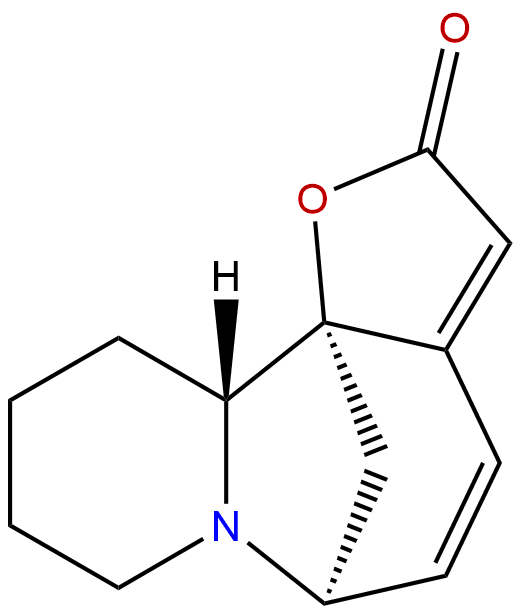
SecurinineCAS No.:5610-40-2
|
||||||||||
 |
|
|
||||||||

| Catalogue No.: | BP3361 |
| Formula: | C13H15NO2 |
| Mol Weight: | 217.268 |
Product name: Securinine
Synonym name:
Catalogue No.: BP3361
Cas No.: 5610-40-2
Formula: C13H15NO2
Mol Weight: 217.268
Botanical Source:
Physical Description:
Type of Compound: Alkaloids
Purity: 95%~99%
Analysis Method: HPLC-DAD or/and HPLC-ELSD
Identification Method: Mass, NMR
Packing: Brown vial or HDPE plastic bottle
The product could be supplied from milligrams to grams. Inquire for bulk scale.
We provide solution to improve the water-solubility of compounds, thereby facilitating the variety of activity tests and clinic uses.
For Reference Standard and R&D, Not for Human Use Directly.
Description:
Securinine, a GABAA receptor antagonist, enhances macrophage clearance of phase II C. burnetii: comparison with TLR agonists. It is alsoia promising new monocytic differentiation inducing agent for Acute Myeloid Leukemia (AML). Securinine shows antifungal activity against some plant pathogenic fungi.
References:
Zhongguo Yao Li Xue Bao. 1999 Mar;20(3):267-70.
Securinine induced apoptosis in human leukemia HL-60 cells.
To study whether Securinine might induce apoptosis in human leukemia HL-60 cells.
METHODS AND RESULTS:
Inhibition of proliferation was measured using MTT assay. The amount of apoptotic cells was measured by flow cytometry. DNA fragmentation was visualized by DNA agarose gel electrophoresis and the cellular changes were observed by electron microscope. Securinine 5-80 mg.L-1 elicited typical apoptosis morphological changes and DNA fragmentation in a concentration-dependent manner in HL-60 cells. Securinine inhibited HL-60 cell proliferation in a time- and concentration-dependent manner. The IC50 and 95% confidence limits were 27 (15-47) mg.L-1 after 12-h treatment with Securinine.
CONCLUSIONS:
Securinine induced apoptosis in HL-60 cells.
PLoS One. 2011;6(6):e21203.
Securinine, a myeloid differentiation agent with therapeutic potential for AML.
As the defining feature of Acute Myeloid Leukemia (AML) is a maturation arrest, a highly desirable therapeutic strategy is to induce leukemic cell maturation. This therapeutic strategy has the potential of avoiding the significant side effects that occur with the traditional AML therapeutics.
METHODS AND RESULTS:
We identified a natural compound Securinine, as a leukemia differentiation-inducing agent. Securinine is a plant-derived alkaloid that has previously been used clinically as a therapeutic for primarily neurological related diseases. Securinine induces monocytic differentiation of a wide range of myeloid leukemia cell lines as well as primary leukemic patient samples. Securinine's clinical potential for AML can be seen from its ability to induce significant growth arrest in cell lines and patient samples as well as its activity in significantly impairing the growth of AML tumors in nude mice. In addition, Securinine can synergize with currently employed agents such as ATRA and decitabine to induce differentiation.
CONCLUSIONS:
This study has revealed Securinine induces differentiation through the activation of DNA damage signaling. Securinine is a promising new monocytic differentiation inducing agent for AML that has seen previous clinical use for non-related disorders.
Mycobiology. 2008 Jun;36(2):99-101.
Antifungal Activity of Securinine against Some Plant Pathogenic Fungi.
METHODS AND RESULTS:
The alkaloid Securinine was assessed against spore germination of some plant pathogenic and saprophytic fungi (Alternaria alternata, Alternaria brassicae, Alternaria brassicicola, Curvularia lunata, Curvularia maculans, Curvularia pallenscens, Colletotrichum musae, Colletotrichum sp., Erysiphe pisi, Helminthosporium echinoclova, Helminthosporium spiciferum, Heterosporium sp.). Spore germinations of all the tested fungi were inhibited.
CONCLUSIONS:
Alternaria brassicicola, C. lunata, C. pallenscens and H. spiciferum were highly sensitive as complete inhibition of spore germination was observed at very low concentrations (200 ppm).
J. Leukoc. Biol.,2007, 82(5):1062-1069.
Securinine, a GABAA receptor antagonist, enhances macrophage clearance of phase II C. burnetii: comparison with TLR agonists.
Innate immune cell stimulation represents a complementary approach to vaccines and antimicrobial drugs to counter infectious disease.
METHODS AND RESULTS:
We have used assays of macrophage activation and in vitro and in vivo phase II Coxiella burnetii infection models to compare and contrast the activity of a novel innate immune cell agonist, Securinine, with known TLR agonists. As expected, TLR agonists, such as LPS (TLR4) and fibroblast-stimulating lipopeptide-1 (FSL-1; TLR2), induced macrophage activation and increased macrophage killing of phase II C. burnetii in vitro. FSL-1 also induced accelerated killing of C. burnetii in vivo. Securinine, a γ-aminobutyric acid type A receptor antagonist, was found to induce TLR-independent macrophage activation in vitro, leading to IL-8 secretion, L-selectin down-regulation, and CD11b and MHC Class II antigen up-regulation. As seen with the TLR agonists, Securinine also induced accelerated macrophage killing of C. burnetii in vitro and in vivo.
CONCLUSIONS:
In summary, as predicted by the literature, TLR agonists enhance macrophage killing of phase II C. burnetii in vitro, and at least for TLR2 agonists, this activity occurs in vivo as well. Securininerepresents a novel macrophage agonist, which has similar effects as TLR agonists in this model yet apparently, does not act through known TLRs. Securinine has minimal toxicity in vivo, suggesting it or structurally similar compounds may represent novel, therapeutic adjuvants, which increase resistance to intracellular pathogens.ge killing of C. burnetii in vitro and in vivo. In summary, as predicted by the literature, TLR agonists enhance macrophage killing of phase II C. burnetii in vitro, and at least for TLR2 agonists, this activity occurs in vivo as well. Securininerepresents a novel macrophage agonist, which has similar effects as TLR agonists in this model yet apparently, does not act through known TLRs. Securinine has minimal toxicity in vivo, suggesting it or structurally similar compounds may represent novel, therapeutic adjuvants, which increase resistance to intracellular pathogens.